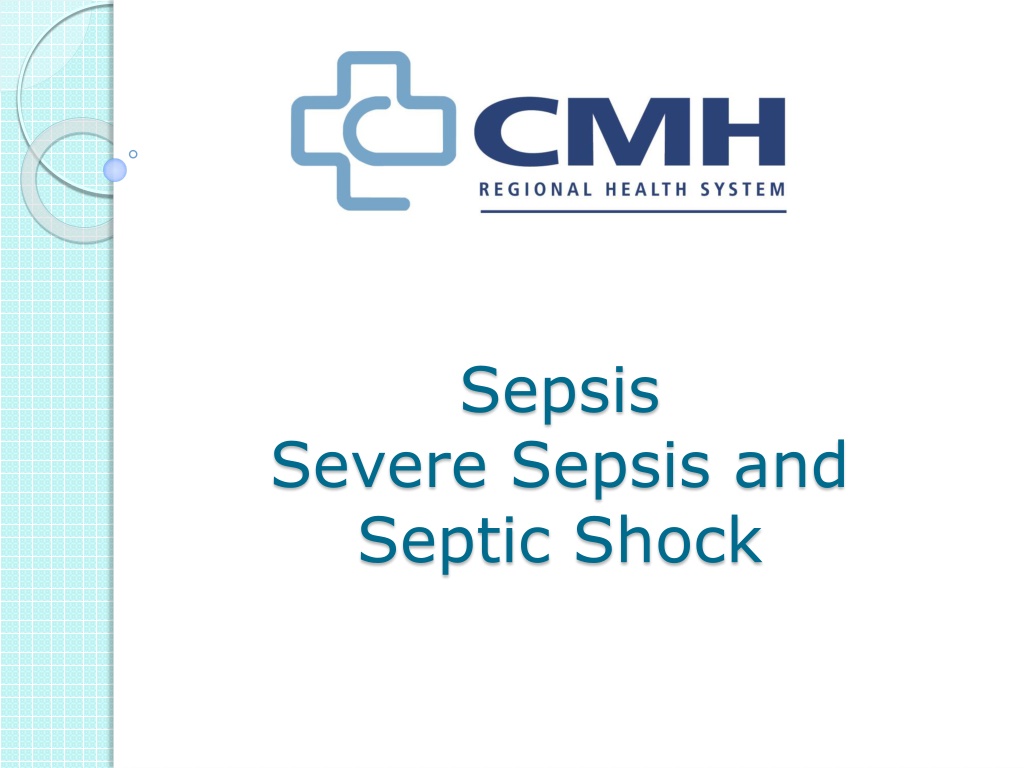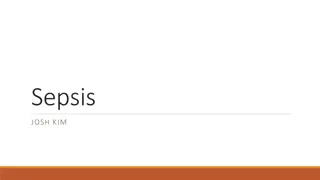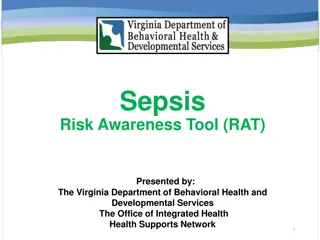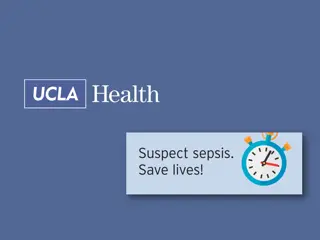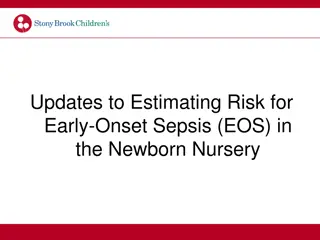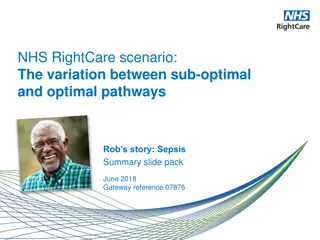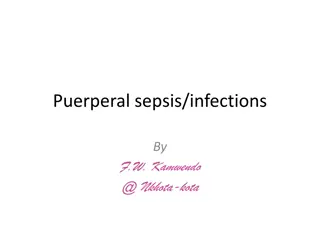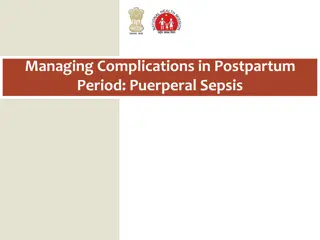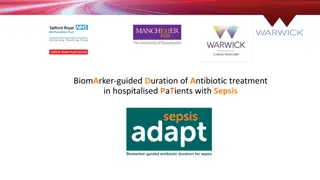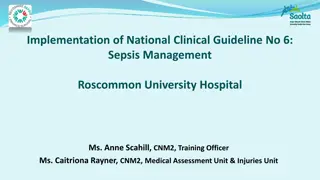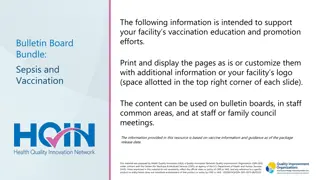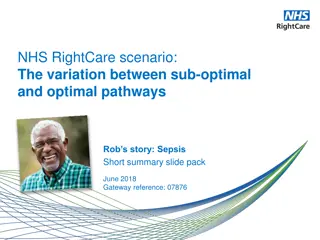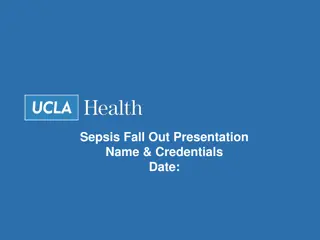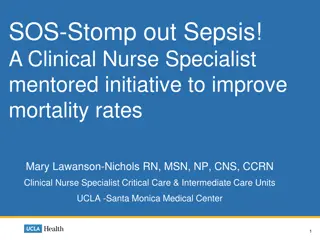Understanding Sepsis and Its Impact on Patient Care
Sepsis is a life-threatening condition resulting from the body's response to an infection, leading to shock, multiple organ failure, and potentially death if left untreated. Recognizing and treating sepsis promptly is crucial, as it has a high mortality rate and can have a significant impact on patient outcomes. Learn about the criteria for sepsis, severe sepsis, and septic shock, as well as the importance of following the Severe Sepsis/Septic Shock Protocol for optimal patient care and outcomes.
Download Presentation

Please find below an Image/Link to download the presentation.
The content on the website is provided AS IS for your information and personal use only. It may not be sold, licensed, or shared on other websites without obtaining consent from the author. Download presentation by click this link. If you encounter any issues during the download, it is possible that the publisher has removed the file from their server.
E N D
Presentation Transcript
Sepsis Severe Sepsis and Septic Shock
Objectives: Understand the criteria for Sepsis, Severe Sepsis and Septic Shock Understand the treatment for Severe Sepsis by utilizing the CMH Severe Sepsis/Septic Shock Protocol (you may print the protocol for reference)
What is Sepsis? Sepsis is a life threatening condition that arises when the body s response to an infection injures its own tissues and organs. Sepsis leads to shock, multiple organ failure and death, especially if not recognized early and treated promptly.
How does Sepsis impact our patients? Sepsis kills more people each year than Breast Cancer, Colorectal Cancer, Pancreatic Cancer, and Prostate Cancer COMBINED! Sepsis has a high mortality in part because the early symptoms are not recognized. In 2014 Sepsis accounted for 48% of Acute Care Deaths.
Why has CMS made Severe Sepsis/Septic Shock a core measure? All of the measures outlined in our protocol were based on the Surviving Sepsis Campaign and align with measures from the Centers for Medicare and Medicaid Services. (CMS) Studies show using a sepsis protocol had decreased mortality.
Why does the Severe Sepsis/Septic Shock core measure matter to me? It s the best care we can give to our patients. The results of our care is reported on the Hospital Compare website. Future payments from CMS will be based, in part, by our performance on this measure.
Sepsis Criteria: Known or Suspected Infection (Physician or RN documentation) (Can be confirmed, suspected, or possible) Examples of RN documentation: In ED earlier, diagnosed with UTI. Currently on oral antibiotics for pneumonia. And 2 or more SIRS (Systemic Inflammatory Response Syndrome) criteria, which are: Temperature <96.8 or >100.9 Heart Rate >90 bpm Respiratory Rate >20/min WBC count <4,000 or >12,000 or >10% Bands
Severe Sepsis = Sepsis + Acute Organ Dysfunction Acute Organ Dysfunction is defined by any ONE of the following: Lactate >2mmol/L INR >1.5 or aPTT >60 seconds Platelet count <100,000 Bilirubin >2mg/dL Creatinine >2, or urine output <0.5 mL/kg/hour for 2 hours Systolic Blood Pressure (SBP) <90 mmHg, or mean arterial pressure < 65 mmHg, or decrease in SBP more than 40 mmHg from previously recorded SBP Abnormal lab values from a chronic condition will not meet criteria.
Septic Shock Septic shock = Severe Sepsis with hypotension unresponsive to fluid resuscitation (30ml/kg) OR Lactate >4 Hypotension is defined as: Systolic blood pressure <90 or Mean Arterial pressure <65 or Decrease of Systolic blood pressure >40 points
Points to Remember: This core measure is all or nothing, meaning we either provided the best possible care or we did not. No partial credit for doing some of the treatments outlined.
Presentation Time: Presentation time is the time the last criteria was met for severe sepsis or physician documentation of severe sepsis. This will start the clock for our interventions!
Presentation Time Example #1: All of the criteria for severe sepsis must be met within 6 hours of each other. 0800 Lactate = 2.3 (organ dysfunction) So we look back at the previous 6 hours. 0630 vitals Resp rate 24 and HR 120 (2 SIRS criteria) 0700 physician documentation of possible UTI (infection criteria) All 3 criteria were met within 6 hours of each other Severe Sepsis Present Since the lactate reported time at 0800 was the last of the three criteria, Severe Sepsis Presentation time = 0800
Presentation Time Example #2: 1200 WBC = 14,500 resulted (1 SIRS criteria) Review the period 6 hours prior (0600-1200) for the other criteria 0900 physician documentation of pneumonia (infection criteria) No sign of organ dysfunction in 0600-1200 time frame Review period 6 hours after earliest criteria met at 0800 (0800-1400) 1300 the patient s BP is 88/50 (organ dysfunction) All 3 criteria were met within 6 hours of each other Severe Sepsis present Since the time of the hypotension at 1330 was the last of the 3 criteria, the Presentation Time=1300
CMH Severe Sepsis / Septic Shock Protocol Two Clocks Severe Sepsis: 3 hour and 6 hour Counters Septic Shock: 3 hour and 6 hour Counters
CMH Severe Sepsis / Septic Shock Protocol Severe Sepsis 3 hour Counter: To be completed within 3 hours of time of presentation: 1. Measure lactate level 2. Draw Blood cultures (before antibiotic administration) 3. Administer Broad Spectrum Antibiotics 4. Administer NS or Lactated Ringers 30ml/kg for hypotension or lactate >4mmol/L
CMH Severe Sepsis / Septic Shock Protocol Severe Sepsis 6 hour Counter: To be completed within 6 hours of time of presentation: 1. Repeat Lactate level (if initial lactate was >2)
CMH Severe Sepsis / Septic Shock Protocol Septic Shock 3 hour Counter: To be completed within 3 hours of time of presentation: 1. Measure lactate level 2. Draw Blood cultures (before antibiotic administration) 3. Administer Broad Spectrum Antibiotics 4. Administer NS or Lactated Ringers 30/ml/kg for hypotension or lactate >4mmol/L
CMH Severe Sepsis / Septic Shock Protocol Septic Shock 6 hour Counter: To be completed within 6 hours of time of presentation: 1. Repeat Lactate level (if initial lactate was >2) 2. If hypotension persists after fluid resuscitation begin vasopressors (see protocol) Hypotension is defined as: Systolic blood pressure <90 or Mean Arterial pressure <65 or Decrease of Systolic blood pressure >40 points
Documentation Document the Start time and End time of any boluses given. The physician order for any IV fluid bolus should include: Type of fluid, total volume to infuse and timeframe for infusion. Physicians will be given this education.
Cheat Sheet Severe Sepsis Septic Shock Within 3 hours of presentation Measure Lactate Blood culture before antibiotics Antibiotics given Measure Lactate Blood culture before antibiotics Antibiotics given Fluid Resuscitation 30ml/kg crystalloid NS or LR Within 6 hours of presentation If hypotension persists after fluid: SBP <90, MAP <65, SBP >40 points If initial Lactate elevated: Repeat Lactate Vasopressors - See list AND Repeat volume status and tissue perfusion assessment using either MD/PA/NP focused exam including : Vital Signs - need all T, P, R, BP documentation includes values Cardiopulmonary Exam - need reference to both heart and lungs Cap Refill evaluation Peripheral pulse evaluation include location Skin exam - reference to color OR Any 2 of the following : CVP Measurement Central Venous Oxygen measurement SvO2 or ScvO2 - must be obtained via central venous catheter Bedside Cardiovascular Ultrasound Passive Leg Raise or Fluid Challenge PLR done by MD/PA/NP
This is a lot of information so your PI team is here to help! PI will be conducting daily review of all of our inpatients looking for Sepsis/Severe Sepsis and Septic shock. We will be giving out pocket cards that will contain criteria and treatments for Severe Sepsis/Septic Shock. We are all in this together!!!
